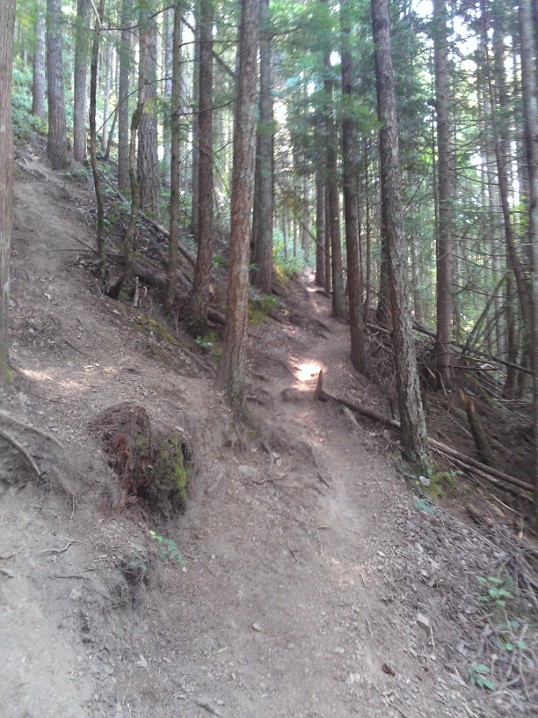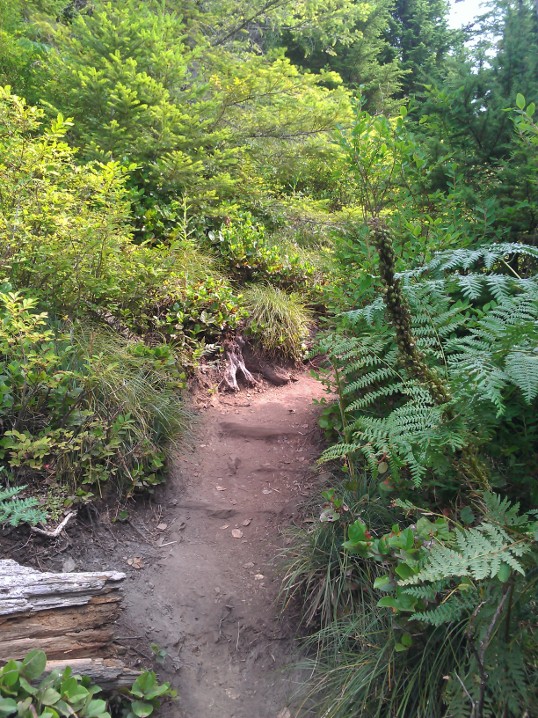
 |
Menu |  |
|
|
||
 |
Welcome to UptonArt.netMailbox Peak hikeposted August 19th, 2012 in Trip reports As I continue to, er, not update the theme or upload my photos, I figured I should add other content. So, trip reports! Hiking, driving (whenever I have another one of those), whatever. Today I hiked Mailbox Peak. I’d heard it was a rite of passage of sorts for hiking around the Cascades, so I figured that was a good one to bump up the difficult level a bit. “A bit.” As the link above mentions, this is intense. I tracked it with my Fitbit and it’s not clear whether the Fitbit’s altimeter is finicky at higher elevations or if the WTA description is wrong — it claims 4100 feet elevation gain, but I “only” hit 3500 on my way to the top. Over the course of 3 miles, plus or minus, that’s pretty steep either way. I’d actually tried last week, but I missed the trailhead and hiked around on a fire road for a while, and by the time I figured out where I’d gone wrong I was too tired to start the proper trail. The first part of the trail is lower in the forest and, although it mostly keeps with the focus of getting as much elevation as quickly as possible, it does have a few switchbacks and is fairly well marked. Around 1500 feet up from the parking lot, white diamonds as trail markers start showing up on trees, frequently with inspirational messages of sorts (“Pain is weakness leaving the body,” “How high can you fly?,” “You only fail if you give up”).
Around 2000 feet up, there are two big changes: the commentary on the trail markers disappears, and the trail markers become basically the only way to figure out where you’re going. Sure, there are rough trails kicked in by use, but the trail at this point is basically “dirt and roots that are slightly more packed than the surrounding dirt and roots.” Somewhere around 2500 feet up, it changes from older growth to newer growth forest, with shorter trees and generally much more open. This is also where you first start to get views of the I-90 corridor and Issaquah locally, and Mount Rainier further off to the south.
At 3000 feet, you get to make a choice: Continue through more dense woods, or scramble up a boulder field. A sign at the bottom of the trail warns that people not-infrequently get lost coming back down while trying to avoid the boulder field, so I joined another guy who reached the boulders at about the same time I did and we went straight up the rocks. It was actually one of the easier sections of the trail…but it was also a bit of a tease. The other guy seemed to think that the boulder scramble was the end, so of course he was disappointed; I knew better, but the trail seemed to get even steeper for the last few hundred feet of elevation gain.
Coming back down: I have no idea how people get lost on the way down. Maybe they’ve put in new signage because of the problems, but the trail at that point is fairly well marked (including giant burnt wood signs that say “Trailhead” and have an arrow) without anything that would encourage a hiker to head off in another direction. But either way, after slogging 3 miles up something that steep, my legs were pretty tired, and it actually takes a fair amount of effort to come back down as well — both due to slowing yourself down on the steep trail, and keeping traction despite lots of loose rocks even in the deep forested section. Also: Lesson learned, carry more water than you think you need. I was fine for food (a peanut butter & jelly sandwich and two Clif bars, plus one in reserve), but even on a mild day I had to ration water. Ironically, I was much better prepared in terms of water for last week’s aborted attempt. I didn’t take my DSLR because I didn’t want to add any more weight than necessary, and the point & shoot I had grabbed decided to give up halfway through summit pictures (not surprising; it had been totally busted and I barely managed to fix it in the first place), so basically all I had were cell phone photos. Oh well. You could only kind of see Mount Rainier and Mount Baker, anyway. No Comments on Mailbox Peak hikeThoughts on Spotify, Part 2posted July 20th, 2011 in Music Now that Spotify has finally launched in the US, and now that I’ve gotten an invitation and have had an opportunity to try out the free version… One of the benefits of Spotify is supposed to be social discovery, easy sharing of playlists and whatnot. Of course, with this limited rollout, I only know two or three other people with accounts, and I don’t think anybody has shared playlists. Then again, neither have I. I did see one person sharing a track on Facebook, using the Spotify FB app, but for now I’m not installing that connectivity — it asks for way too many permissions without giving any good reason for why. Barring social discovery, I wish it had a better exploration mechanism for discovery. On the one hand, the ability to browse by artist works really well, and it includes all of the albums they have available by that artist as well as all of the collections they’ve appeared on. Or, on the first day I’d logged in and messed around with it much, I found a dozen or so Vitamin String Quartet albums (the guys who do the “String Tribute To…” series) to add to a list to listen to later. But about the best it does for other discovery is a handful of random albums on the front page, or 5 or 6 “similar artists” listed when you go to an artist page. I kind of wish there were a good genre browser, with more specific genres instead of just lumping virtually everything under “rock & pop,” although for that matter it wouldn’t even hurt to be able to browse all rock & pop, all jazz, all bluegrass, etc. I’m sure that, theoretically, curated genre playlists are a part of the social discovery. The collection is also sort of weird. I think I’ve read that it has the largest catalog of any comparable service, with Wikipedia quoting “15 million, growing by 10,000 per day.” But the actual contents are uneven. I started off searching for Loreena McKinnett’s “Mummer’s Dance,” which failed (not least of which because it doesn’t have a very good “did you mean x?” feature for misspelled names). I did find a slightly different version that had appeared on some kind of compilation CD, but they didn’t have her full CD that had the original track. But then it has apparently every VSQ album, tracks from a variety of indie labels, and a smattering of albums that really surprised (and pleased) me (like Jeff Kollman’s Shedding Skin (spotify link)). When I searched for Porcupine Tree’s Voyage 34, instead it came up with a track from an audiobook. They don’t seem to have anything by 3, and they’re missing a variety of older CDs that I checked ranging from bands like Tribal Tech to Coheed & Cambria. The ad-supported nature can be frustrating, just because your playlists will be interrupted with a loud ad that usually has nothing to do with what you were listening to. And spoken ads I don’t really mind, but when it comes on in the middle of a jazz fusion playlist with this (terrible) R&B song they’re pushing pretty hard, it’s jarring. Maybe they’ll eventually be able to extend their ad base and that problem will go away. The interface is quirky but acceptable. The biggest problem is that double-clicking on a song in a results page enqueues that song and then every other song on the page after it, which makes building playlists on the fly kind of…weird. Enqueueing a song later will insert songs in the order you would expect, but then once you’re done queueing things up it goes back to whatever was on the page when you originally played the first song. So I’ll keep using the free service for now and put up with the annoying ads, but I don’t know if I’m excited enough by it yet to pay for a subscription, even when it switches to only having 10 hours per month and a max 5 plays per track. The benefit of the $10/month subscription would be being able to listen to the full library from a smartphone, but I usually have my Zune or the CDs handy for most music I would come up with to listen to on the road. (Plus, you know, the whole not having a smart phone thing.) 1 Comment on Thoughts on Spotify, Part 2On Spotifyposted July 7th, 2011 in Music So it’s official: Spotify is coming to the US. I’d heard something to that effect last weekend, when MetalSucks claimed that a well-informed insider had confirmed that the last holdout, Warner Bros., had finally gotten on board with the service. On the one hand, this is pretty exciting. I’ve been waiting a while for a way to access Spotify after hearing about all the great stuff it can do from people on the other side of the pond. Specifically, a musician I follow on Twitter would frequently post Spotify playlists for music he was into at the time or thought other people should check out. And of course, the press ravings make it sound pretty excellent, with nice text-bites like “the celestial jukebox” and “a magical version of iTunes in which you’ve already bought every song in the world.” On the other hand, I’m a little dubious about the end result. For a long time, Spotify was free and ad-supported, but looked to make most of its money off of getting people to pay for an upgraded solution that included offline access to music. Of course, that offline access to music is only good if you’re paying for the subscription, so that means it’s DRMed, which (deservedly) usually gets a knee-jerk reaction. But after realizing they weren’t really going to stay afloat on that model, they changed to try to get more conversions: the current free version is only truly unlimited for 6 months, and then switches to a limited version with only 10 hours of listening time per month and a max of five listens per track. So let’s compare that to the various music services that exist or have existed in the US, based on my understanding of them (which means I’m not going to do the research to doublecheck these, so feel free to let me know in the comments if I’ve missed something): Ruckus Network : Free, ad-supported, DRMed music service. Ruckus was initially available only to students at certain universities but eventually opened to everybody with a .edu address who was willing to put in a graduation date. Unlike Spotify, there were no audio ads, just usually a really annoying ad on the landing page and then banner ads throughout the rest of the site. And I guess the Ruckus downloader/player had ads, too, although you didn’t have to listen to music through that interface. I thought it was great, but it never really took off, partly because they never worked out (or, never released) a way to take your music on mobile devices. Actually, the real problem was that it was all based on Windows Media audio files, which basically cut out any Mac users and precluded songs from even being played on an iPod. I think you could authorize two or three machines, and had to reconnect to the service once every 30 days to reset your DRM licenses. It went dark in February 2009 without warning, presumably due to lack of revenue from ads. Spiralfrog: Basically the same thing as Ruckus, as far as I could tell, although without the .edu limitation, and with a much (MUCH) dodgier interface. Nothing ever wanted to download, the library was more limited, and it didn’t even centralize the downloader with a media player. Still, it was a nice holdover…for about a month, before it went dark, too. Zune Pass: No free model that I’m aware of; for some fee ($15/month, maybe?), you get unlimited listens on PCs and Zune-compatible devices, plus 10 tracks to keep. So if it’s $15, you basically buy a CD and then pay $5 for unlimited listening to anything else. Better than Spotify’s paying to take it on the go but losing it if you ever quit subscribing… but of course, still relatively few people have Zunes or Windows 7 Phones, and the DRM is (again) implemented as Windows Media audio files that the iPodders can’t play. Rhapsody: My understanding is that this is kind of like Spotify except again with no real free model to speak of, and none of the social sharing features. So really, what it seems like Spotify has over the apparent best-by-features of those is social features, a limited free model, and presumably DRM that will be more general across devices. That said, I’ll probably use the free version as long as I can, but I can’t imagine ever wanting to pay for it. (But then again, I’m one of those semidinosaurs who still prefers to have a physical CD whenever possible.) No Comments on On SpotifyA few authorly shout-outsposted June 27th, 2011 in Friends,Site News,Writing Some visitors may know that at some point, I’d like to write a novel. Especially since I’ve crossed “record and sell at least one CD” off of my to-do list. (Maybe I should’ve set the bar a little higher, but this was before just anybody could release a record on Bandcamp.) I’d started a few times in high school but never quite finished. Maybe I’ll finally get to do National Novel Writing Month this year, finally, and get a little closer. But it turns out several of my friends are aspiring authors as well and write blogs, either about the writing process or as an entertaining aside to their main writings. So, here’s a shout-out to the ones I know off-hand: In other news, yes, I know, I still haven’t changed the layout or started the process of posting photos. But one day, before the end of the year at worst, there should be a grand unveiling. I’m just too nitpicky about the presentation to settle on something! No Comments on A few authorly shout-outsNew Review: Circles – The Compassposted June 21st, 2011 in Music,Reviews New review posted at Metalship: Circles – The Compass |
 |
Recent |  |


